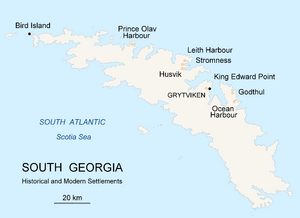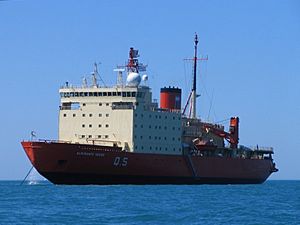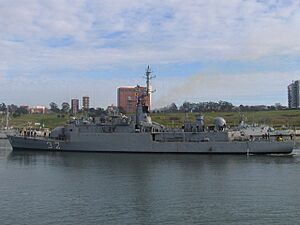Invasion of South Georgia facts for kids
Quick facts for kids Battle of Grytviken |
|||||||
|---|---|---|---|---|---|---|---|
| Part of the Falklands War | |||||||
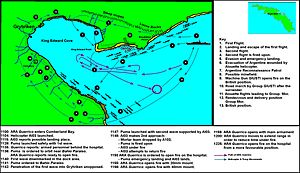 Grytviken, 3 April 1982 |
|||||||
|
|||||||
| Belligerents | |||||||
| Commanders and leaders | |||||||
| Units involved | |||||||
| Strength | |||||||
|
|
||||||
| Casualties and losses | |||||||
|
|
||||||
The Battle of Grytviken, also known as the invasion of South Georgia or Operation Georgias, happened on April 3, 1982. During this event, the Argentine Navy took control of the east coast of South Georgia. They did this by defeating a small group of Royal Marines stationed at Grytviken.
Even though the Royal Marines were greatly outnumbered, they fought bravely. They managed to shoot down one helicopter and hit the Argentine warship ARA Guerrico several times. However, they were eventually forced to surrender. This battle was one of the first major events of the Falklands War. It happened right after the invasion of the Falkland Islands the day before.
The plan for this operation began on March 19. On that day, a group of Argentine workers arrived at Leith Harbour on a ship called ARA Bahía Buen Suceso. They were supposed to remove scrap metal. However, they landed without permission and raised the Argentine flag. It was later found out that some of these "workers" were actually Argentine marines pretending to be scientists.
Contents
Events Leading to the Battle
On March 19, the only British people at Leith were a team from the British Antarctic Survey (BAS). Their leader, Trefor Edwards, gave a message from London to the captain of the Buen Suceso, Captain Briatore. The message demanded that the Argentine flag be taken down and the group leave. It also said the Argentine crew needed to report to Steve Martin, the top BAS commander in Grytviken. Captain Briatore claimed his mission had been approved by the British embassy in Buenos Aires.
Eventually, the Argentine captain ordered the flag to be lowered. But he did not report to Grytviken. The BAS commander sent a message to Rex Hunt, the Governor of the Falkland Islands. South Georgia was managed as a dependency of the Falklands. After talking with London, Governor Hunt was told to send HMS Endurance to South Georgia. This ship carried 22 Royal Marines.
The reason for the scrap metal workers landing at Leith was a contract from 1978. An Argentine businessman, Constantino Davidoff, had a deal with a British company to remove an old whaling station on the island. The Argentine Navy knew about this contract. They planned to use Davidoff's business as a cover to set up a secret base on the island. This secret plan was called Operation Alpha.
There had been two other Argentine trips to South Georgia before this. In December 1981, Davidoff had checked the facilities on the Argentine icebreaker ARA Almirante Irízar. In February 1982, another person, Adrian Marchessi, visited Leith without warning. He claimed to be part of Davidoff's plan and gave British officials details about earlier Argentine visits.
Because the Argentines did not follow the proper rules, Britain decided to act. A formal protest was sent by the British embassy in Buenos Aires. The Argentine Foreign Minister's reply seemed to calm things down. He said the Buen Suceso would leave soon and that the mission had no official approval. By the morning of March 22, Buen Suceso had left Leith harbour. However, later that day, a BAS observation post saw Argentine personnel still there. They reported this to London. So, the British Foreign Office ordered HMS Endurance to remove any Argentines remaining on South Georgia.
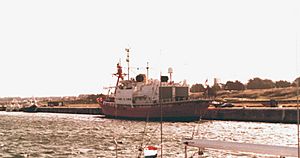
Britain's actions led to Argentine responses. The warships ARA Drummond and ARA Granville were sent between the Falklands and South Georgia. This would allow them to stop Endurance. When Endurance arrived at Leith, it found the Argentine ship ARA Bahía Paraíso already there. This ship had landed 10 naval commandos.
Facing possible military action, the British Foreign Office looked for a solution. Lord Carrington suggested to his Argentine counterpart, Nicanor Costa Méndez, that the workers could stay at Leith if they had the right documents. This could include temporary permits instead of passports. This was important to the Argentine side. However, Argentina wanted their citizens to follow rules from a 1971 agreement. Governor Rex Hunt strongly disagreed with extending this agreement to South Georgia. He told the British government his concerns. Both countries were now very close to a conflict.
The Battle Begins
April 2nd: Preparations
Just before Argentina landed troops on the Falklands, Bahía Paraíso and Endurance were playing a game of cat-and-mouse around South Georgia. By March 31, the ships had lost track of each other. The British plan was for Steve Martin to be in charge until the Argentines showed hostile intentions. If that happened, Acting Lieutenant Keith Mills, the highest-ranking Royal Marines officer, would take command.
Lieutenant Mills received a radio message from HMS Endurance. It told him to offer only a small resistance to any Argentine invasion. It was reported that he replied, "sod that, I'll make their eyes water." However, Mills later said this story was not true. On April 2, an Argentine officer told the Argentine group in Leith that Argentina had taken over the Falklands.
Meanwhile, the Argentine navy ordered the warship ARA Guerrico to join Bahía Paraíso at Leith. The Guerrico had two helicopters and carried 40 marines. Its goal was to capture Grytviken. This group was called Grupo de Tareas 60.1 and was led by Captain Trombetta on board Bahía Paraíso.
After hearing that Stanley had fallen, Lieutenant Mills took quick action. His men strengthened the beach at King Edward Point, near the bay's entrance, with wire and landmines. They also set up defenses around the BAS buildings. Endurance, which was a few miles offshore, would help them communicate with London. The new rules allowed Mills to "fire in self-defense, after warning." A later British government statement told the marines "not to resist beyond the point where lives might be lost for no reason."
On the Argentine side, their plans for April 2nd in South Georgia were ruined by bad weather. They had planned to land special forces near Grytviken to secure the area for more troops. The Guerrico was supposed to provide fire support from the sea. But the warship was delayed by a storm. So, a new plan was made for the next day.
The new plan was for the first landing to be led by Guerrico's helicopter. Then, three waves of marines would arrive on a Puma helicopter from Bahia Paraiso. After sending a radio message demanding the British surrender, Captain Trombetta would order Guerrico to enter Grytviken harbor, right in front of King Edward Point. The Argentine rules said the warship could only fire if the landing parties asked for help. All forces were told to avoid harming enemy soldiers if possible.
April 3rd: The Battle
At 10:30 AM GMT, as the weather got better, Bahia Paraiso demanded Grytviken's surrender. The message falsely claimed that Rex Hunt had surrendered the Falklands and its dependencies. Lieutenant Mills copied and sent the message to HMS Endurance to gain time. At the same time, he told the BAS staff to take cover inside the local church. By then, an Argentine helicopter was flying over Grytviken, and Guerrico was entering the cove.
Helicopter Shot Down

At 11:41 AM, the Puma helicopter landed the first group of 15 Argentine marines at King Edward Point. This was on the opposite side from Shackleton House, where the Royal Marines were hiding. By this time, Guerrico knew that the Royal Marines were mostly on the northern shore of the cove's entrance.
The second group of marines took off from Bahia Paraiso on the Puma at 11:47 AM. The Argentine commander on land, Lieutenant Luna, asked for mortars for the second group. But the helicopter was already in the air. This landing was planned to happen east of Luna's position, where the British could easily see it.
Lieutenant Mills and his men saw the helicopter and fired heavily at it. The pilot managed to cross the bay and crash-land on the southern bank. Two Argentine soldiers were killed and four were wounded. At the same time, Luna's troops began moving towards Shackleton House. But the Royal Marines stopped them with strong gunfire. So, Luna asked Guerrico for fire support.
ARA Guerrico Attacked
The warship then entered the cove again, and at 11:55 AM, it opened fire. But its 20 mm guns jammed after the first shot. The 40 mm gun also stopped working after firing only six rounds. The 100 mm gun became useless after its first shot. The warship was completely exposed and had no choice but to keep going to turn around. At 11:59 AM, the Guerrico was hit by small arms fire and at least one anti-tank rocket.
According to Lieutenant Mills, his group fired from about 550 meters away. The shooting killed one Argentine sailor and injured five others. It also damaged electrical cables, the 40 mm gun, an Exocet missile launcher, and the 100 mm gun. Argentine sources agree that more than 200 small arms rounds hit the warship. Meanwhile, another Argentine helicopter was bringing more marines ashore, out of reach of the British weapons.
While the damaged Guerrico steered out of the bay, the Argentine troops continued to exchange fire with Mills' marines. Corporal Nige Peters was hit twice in the arm. Once the Guerrico was out of range, it started firing its 100 mm main gun again, which was now working. This convinced Mills that the battle was over. He ordered his marines to stop firing. This happened at 12:48 PM. Mills approached the Argentine positions waving a white coat and surrendered. He had achieved his goal of forcing the Argentine troops to use military force. Mills and his men were taken by the Argentine group that had been held in reserve during the battle. HMS Endurance sent one of its helicopters to Cumberland Bay. The helicopter landed there and saw an Argentine warship and a transport ship in the cove. But it found no signs of fighting. Endurance stayed in South Georgia waters until April 5.
Aftermath
The warship Guerrico, which had lost half of its firepower due to battle damage, left Grytviken with Bahia Paraiso at 3:15 AM on April 4. They headed for Rio Grande. The Guerrico spent three days in dry dock for repairs. The captured Royal Marines were disarmed and taken on board Bahia Paraiso. They were then taken to Rio Grande and flown to Montevideo.
Marine Andrew Michael Lee later said that he and the other British prisoners were treated well. He felt there was respect between the two sides. "They bore us no malice. They did understand the job we did. They were Marines, like ourselves." The British marines eventually returned to the United Kingdom on April 20. Some British BAS members working in remote areas continued their work until British forces retook the island. Wildlife filmmaker Cindy Buxton and her assistant were evacuated by a helicopter from HMS Endurance on April 30. She later said that Royal Navy personnel had given her and fellow journalist Annie Price a pistol and taught them how to use it. The Argentine Navy left 55 marines on the island. The 39 scrap metal workers also stayed in Leith. South Georgia was retaken by British forces on April 25, 1982, during Operation Paraquet.
In 2013, Michael Poole, who had helped shoot down the Puma helicopter, contacted Víctor Ibáñez. Ibáñez was a former marine corporal who fought against Lieutenant Mills's group. Ibáñez welcomed Poole. He explained, "We're both soldiers, men of honour and knew how to accept the role each one played."
Decorations and Honours
- Lieutenant Mills and Lieutenant Commander John Anthony Ellerbeck (who commanded Endurance's helicopters) were given the Distinguished Service Cross.
- Sergeant Peter James Leach, a Royal Marine, was given the Distinguished Service Medal.
- Captain Nick Barker, HMS Endurance's captain, was made a Commander of the Order of the British Empire.
- Principal Corporal Francisco Solano Páez was awarded Argentina's Medal of Valour in Combat.
In Popular Culture
The TV series The Crown shows the landing of the scrap metal workers at Port Leith in March and the raising of the Argentine flag.
See also
 In Spanish: Operación Georgias para niños
In Spanish: Operación Georgias para niños


